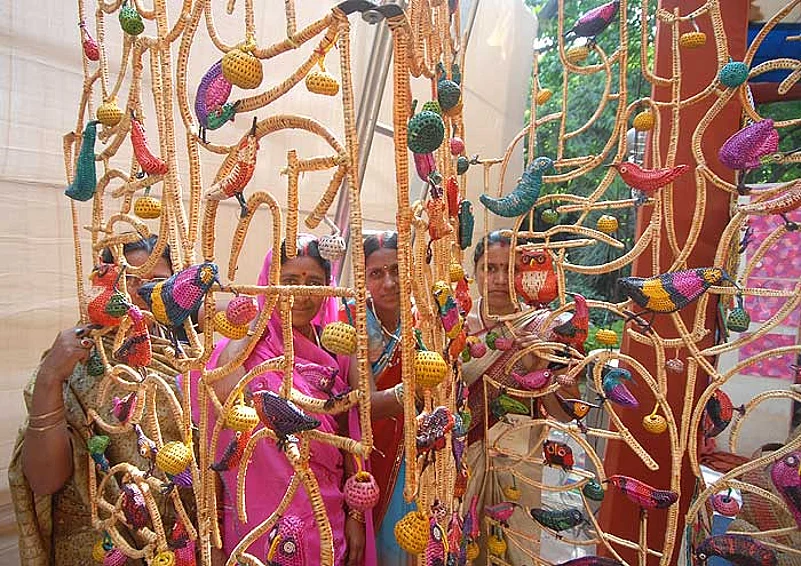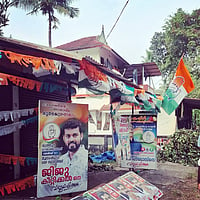Nazda Khatun remembers that wintry night, the chill made worse by the pouring rain, when Amitra Sudan Saha braved the weather to make it to her doorstep. She asked him, “Do guests ever come this late?” But when Saha, a crafts designer with an organisation she had never heard of, called the Asian Heritage Foundation (AHF), explained why he had tracked her down to the dusty village of Jainagar in Bihar’s Madhubani district, all trespasses were forgiven. Saha had come with an offer, and an opportunity. He wanted to harness her talent for weaving grass in a new direction, in order to revive the dying sikki craft. Earlier this month, hunched on the steps of the World Bank office lawns, 40-year-old Nazda recalls this incident and suddenly bursts into tears. Wiping her glasses, she says, “I had talent in my hands but no income.”
In the seven months since she accepted Saha’s offer, Nazda has spent her days working with 49 other fellow craftswomen from Sitamarhi district in Bihar, using the golden grass called sikki to weave giant screens, colourful room dividers, and tables with turnip-shaped legs. These novel creations are a far cry from the standard baskets the women were used to making, and selling for a pittance. As Krishna Devi sits beneath an elaborate woven screen that shows Hindu gods and goddesses playing a game that seems to resemble snakes-and-ladders, she confides, in a child-like way, “Even in my wildest dreams, I never thought I would have been able to do this.”
This touching incredulity is not out of place. The sheer class of the product justifies Krishna Devi’s pride, and while she deserves a fair bit of the credit, some must be reserved for Saha, who imagined it. Once he found his way around Sitamarhi, he found that most women in the district lived under the threat of AIDS or domestic violence, surviving with almost no electricity or roads. Also, the golden grass, which once grew abundantly in ponds and puddles, was becoming increasingly hard to find after large swathes of land were cleared for industrial use.

Trendy meets traditional on a table
Recalls Saha, “These women were old and tired, and even though their minds were willing, their bodies were not.” In an attempt to get them going again, he kicked off a guru-shishya workshop, where women as old as 78 passed on their skills to girls as young as 15. “Middlemen would buy our baskets for Rs 20 and they would then sell them for Rs 150,” says Nazda. “Ab to hum bas Jiyo ke karan jee rahein hain.” (Jiyo has now become our reason to live.)
Jiyo is the name of the project developed by the foundation to reinvigorate the talents of women like Nazda by helping them create trendy, high-end products for the urban market. They call their initiative ‘intervention’, refer to craftsmanship as ‘skill sets’, and talk of crafts ‘clusters’. But as Nazda’s story shows, there is much more to it than jargon. Over the past two years, the AHF has sent designers like Saha, accompanied by coordinators, to 16 different locations in rural Bihar and Andhra Pradesh. They’ve helped Andhra puppet-makers use their traditional skills to produce eye-catching perforated lamps with the same deft touch, given Madhubani painting a new, almost startlingly contemporary spin by helping painters make modular wallpaper (a set of handpainted squares that can be arranged and rearranged on the wall) and have showed weavers how to give a new lease of life to the bavanbuti weaving tradition of Nalanda, by making not just saris but Japanese-style curtains. They’ve also showed pickle-makers from the famed chilli capital, Guntur, to present their products attractively for urban buyers, and sujani embroiderers from Bihar to produce exquisite saris, shawls and scarves that would not be out of place in a top designer’s boutique.
What distinguishes these products from the crafts found in urban haats or exhibitions is their reinvention for a contemporary, global market, their consistently high quality and yes, their prices. A room divider that Nazda helped weave has been priced at Rs 75,000, which is also the cost of each of the low, sleek clean-lined tables that have been richly handpainted in ten traditional painting styles, including Madhubani, Patua and Pichwai. A little too steep? The project’s coordinator, Bhupendra Singh, strongly argues otherwise: “The price tag is just a reflection of what these works are worth. You would pay far more for a worse painting in a gallery,” he says.
Singh points to a table he recently helped paint. The top resembles a cityscape; black windows piled upon each other, connected by the colours of clotheslines. He says, “You find these little black boxes in Pichwai art. The idea came to us that they were perfect for mapping a city.” Shyam Sharma, the traditional Pichwai artist who also worked on this table, smiles encouragingly and adds, “If you have the same subzi everyday, you will tire of it. The same holds true for an art, and for the artist.”

A new light Leather puppet lamp shades from Andhra
Parmesh Shah, a rural development specialist with the World Bank who has been closely involved with the project, focuses on a striking red-and-white Madhubani wallpaper pattern (looking rather like an intricate, giant jigsaw puzzle) displayed at the World Bank office in Delhi along with a host of other Jiyo products. “The idea behind having products as inventive as this one is that what Fabindia did for textiles, Jiyo will do for craft. It will help create a brand.” While the World Bank has put money into building the brand, it must in the end be commercially viable, he emphasises. Jiyo is, in fact, a private limited company with craftspeople and artisans owning 51 per cent of its shares.
Apart from showcasing the products, for buyers and the public, at annual fairs, the plan is also to place them in leading retail stores. Shah lets out a secret: “Louis Vuitton has already expressed interest in stocking our products for a couple of months, as a kind of theme in all its global stores.” Jiyo project manager Anandhi Dasaraj emphasises that this project does not want to go the way of the government-managed Dilli Haat: “Dilli Haat was a noble idea, but it is now swamped by wholesalers from Sarojini Nagar and Chawri Bazaar, diluting the idea of a crafts bazaar for craftspeople.”
What’s happened so far, says Rajeev Sethi, chairman and founding trustee of the AHF, “is not even the tip of the iceberg”. Arguing passionately that India has been unjust to its traditional knowledge sector by casually clubbing it with the unorganised sector, he roars, “At least have the grace of calling them a self-organised sector.” One of the things that convinced him to push the project were his auto-rides through Delhi, during which he discovered that a majority of drivers had left behind lives as skilled craftspeople to earn a livelihood in the city. If Sethi’s predictions are to be believed, the future of Jiyo can best be described as a mass-scale craft talent hunt—and this one deserves to be documented.


























